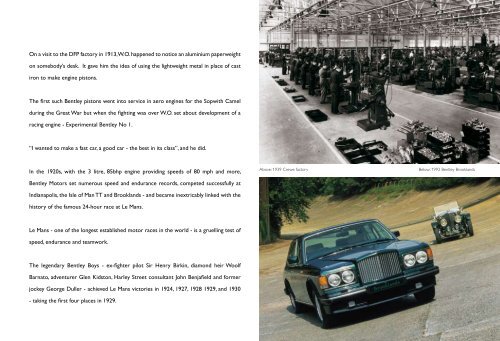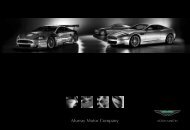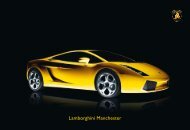Showroom PR - Bentley Pulborough
Create successful ePaper yourself
Turn your PDF publications into a flip-book with our unique Google optimized e-Paper software.
On a visit to the DFP factory in 1913, W.O. happened to notice an aluminium paperweight<br />
on somebody’s desk. It gave him the idea of using the lightweight metal in place of cast<br />
iron to make engine pistons.<br />
The first such <strong>Bentley</strong> pistons went into service in aero engines for the Sopwith Camel<br />
during the Great War but when the fighting was over W.O. set about development of a<br />
racing engine - Experimental <strong>Bentley</strong> No 1.<br />
“I wanted to make a fast car, a good car - the best in its class”, and he did.<br />
In the 1920s, with the 3 litre, 85bhp engine providing speeds of 80 mph and more,<br />
<strong>Bentley</strong> Motors set numerous speed and endurance records, competed successfully at<br />
Indianapolis, the Isle of Man TT and Brooklands - and became inextricably linked with the<br />
history of the famous 24-hour race at Le Mans.<br />
Above: 1939 Crewe factory<br />
Below: 1992 <strong>Bentley</strong> Brooklands<br />
Le Mans - one of the longest established motor races in the world - is a gruelling test of<br />
speed, endurance and teamwork.<br />
The legendary <strong>Bentley</strong> Boys - ex-fighter pilot Sir Henry Birkin, diamond heir Woolf<br />
Barnato, adventurer Glen Kidston, Harley Street consultant John Benjafield and former<br />
jockey George Duller - achieved Le Mans victories in 1924, 1927, 1928 1929, and 1930<br />
- taking the first four places in 1929.








